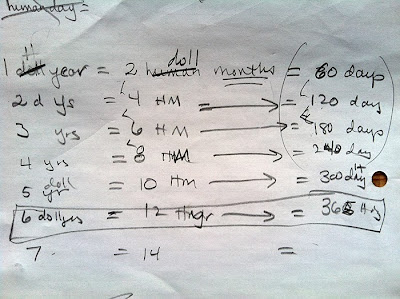So I’m working on a book.
While I work on another book.
This other book is a project through
Moebius Noodles and Maria Droujkova’s
publishing company Delta Stream Media. I’m collaborating with Maria and Gordon
Hamilton of
Math Pickle to create
original puzzles, games, and making activities exploring numerical and categorical
variables … for young kids!
It’s super
awesome extremely cool.
And, today? Today,
our conversations in relation to the variables book helped me clarify something
I’ve been thinking about on a LOT of different levels for literally YEARS.
This level
What’s the difference between using the body to illustrate mathematical ideas and using the body to create and express an understanding of
mathematical ideas?
This other level
What’s the difference between using
body knowledge (ala Papert and his gears) and creating body knowledge?
And finally
What’s the difference between identifying
properties of an object (say, a piece of art, or an insect) and actively choosing from an inventory of
attributes to make your own?
llustrate, use, identify <======> Create, express, choose
Each of these questions needs its own, more specific treatment. My observation today is simply that each pairing
seems to create a similar tension in my mind.
These are all active words, but the nature of the activity is
qualitatively different depending on which side of the learning process you're on.
Today the words fixed and flexible came up in relation to how we are approaching
the activities in the variables book.
Fixed
Puzzles and games that focus on identifying properties happen within a fixed
structure. Using body knowledge to
understand a set of gears assumes that you are using a certain set of body
experiences, created at some point in the past.
Illustrating math ideas using the body means there is a predetermined
goal for the activity and that the outcome needs to look a specific way.
Flexible
Learning vocabulary and language in context and, in math, using multiple strategies to solve a problem are both process oriented and context dependent. In making, having a large inventory of
ideas/things/skills from which to choose and create your own novel ideas (like
a dance step) is an open-ended investigation.
“Fixed” and “Flexible” are not judgments; they are inverses
of each other. They go both ways. Just like you need to compose and decompose numbers to see the full
relationships embedded in those two activities, so do you need to identify and use properties, build and use body
knowledge, and illustrate and express mathematical ideas.
Fixed: The parts of learning (anything, really) that are
perhaps learning objectives that are easier to identify in an assessment, but still crucial. Some call this skill building.
Flexible: Relates to the processes of learning which (as
anyone who has tried arts integration, project based learning, or focusing on
mathematical practices may have experienced) are much harder to nail down when
tasked with assessing such activity.
Some call this fluency.
You can't have one without the other.
“Without
skill there is no art. The requisite variety that opens up our expressive
possibilities comes from practice, play, exercise, exploration, experiment.” --Stephen Nachmanovich, Free Play: Improvisation in Life and Art
Thoughts, feedback, pushback and conversation are always
welcome.








